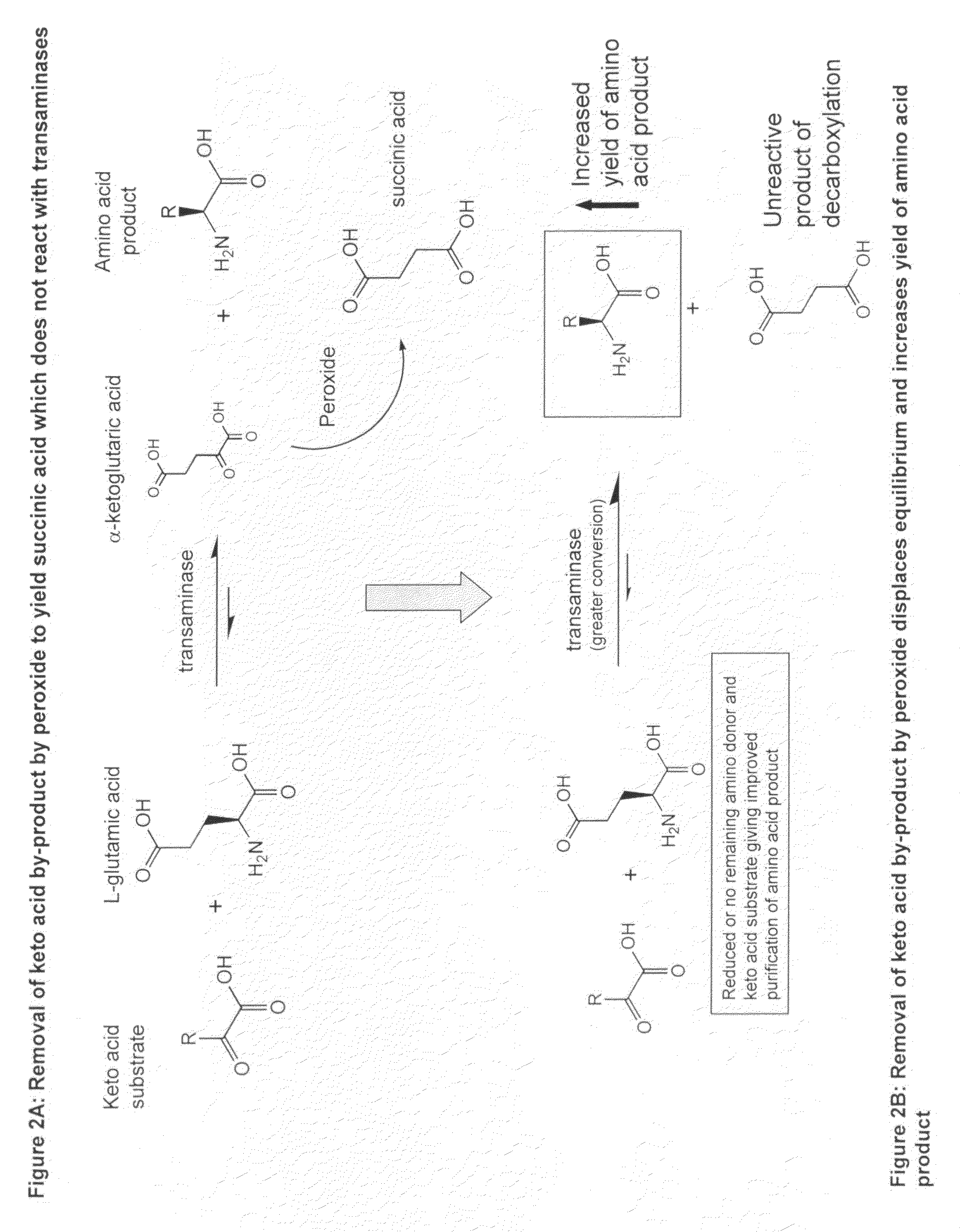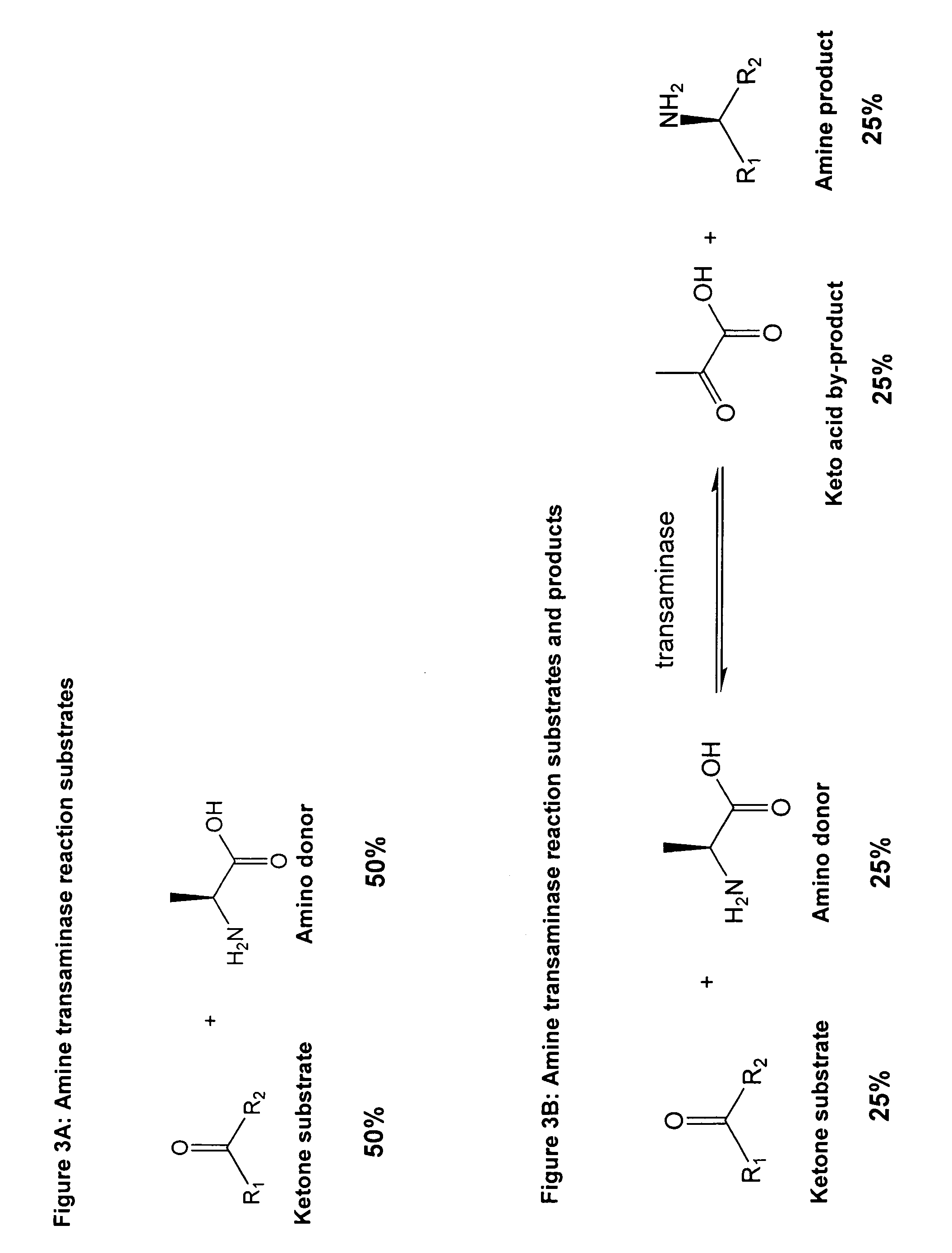Method to increase the yield and improve purification of products from transaminase reactions
a technology of transaminase and product, applied in the direction of fertilization, etc., can solve the problems of sterically hindered keto acids that peroxides do not efficiently decarboxylate keto acids, and achieve the effect of optimizing biocatalytic activity
- Summary
- Abstract
- Description
- Claims
- Application Information
AI Technical Summary
Benefits of technology
Problems solved by technology
Method used
Image
Examples
example 1
Reaction of 3-methyl-2-oxopentanoate Precursor of Desired Amino Acid Product L-isoleucine and Amino Donor L-glutamic Acid
[0045]A reaction mixture comprising 10 mls of water containing 100 mM 3-methyl-2-oxopentanoate and 100 mM L-glutamic acid at pH7.5 and 100 mg / ml whole cell biocatalyst RCI66 is incubated at 40° C. with agitation at 250 rpm for 7 hrs. The biocatalyst is then removed by centrifugation and the alphaketoglutarate content measured by HPLC. The reaction mixture is then cooled to 4° C. and a sub-equimolar concentration of hydrogen peroxide is added to the reaction mixture that is then incubated at 4° C. for 30 minutes. The original biocatalyst is then returned to the reaction which is returned to the 40° C. incubator and allowed to proceed for a further 2 hrs at which point the biocatalyst is removed as before and the reaction mixture treated with hydrogen peroxide as before. The original biocatalyst is discarded and fresh biocatalyst at 100 mg / ml is then added to the re...
example 2
Reaction of Phenylpyruvic Acid Precursor of Desired Amino Acid Product D-phenylalanine and Amino Donor D-glutamic Acid
[0046]A reaction mixture comprising 10 mls of water containing 100 mM phenylpyruvic acid and 100 mM D-glutamic acid at pH7.5 and 100 mg / ml whole cell biocatalyst RC255 is incubated at 40° C. with agitation at 250 rpm for 7 hrs. RC255 is a recombinant E. coli strain which contains a plasmid which expresses the cloned D-aminotransferase from Bacillus sphaericus under the control of the lambda CI857 promoter. The biocatalyst is then removed by centrifugation and the alphaketoglutarate content measured by HPLC. The reaction mixture is then cooled to 4° C. and a sub-equimolar concentration of hydrogen peroxide is added to the reaction mixture that is then incubated at 4° C. for 30 minutes. The original biocatalyst is then returned to the reaction which is returned to the 40° C. incubator and allowed to proceed for a further 2 hrs at which point the biocatalyst is removed ...
example 3
Reaction of 2-butanone Precursor of Desired Amine Product S-2-butylamine and Amino Donor L-alanine
[0047]A reaction mixture comprising 10 mls of water containing 2 mM 2-butanone and 20 mM L-alanine at pH 7.5 and 100 mg / ml whole cell biocatalyst RC209. RC209 is a recombinant strain of E. coli K12 which contains a plasmid which expresses the cloned omega transaminase of A. denitrificans under control of the lambda CI857 promoter region. The reaction is incubated at 37° C. with agitation at 250 rpm for 4 hrs. The biocatalyst is then removed by centrifugation and hydrogen peroxide is added to a final concentration of 10 mM. The original biocatalyst is then returned to the reaction which is returned to the 37° C. incubator and allowed to proceed for a further 2 hrs at which point the biocatalyst is removed as before and the reaction mixture treated with hydrogen peroxide as before. The original biocatalyst is discarded and fresh biocatalyst at 100 mg / ml is then added to the reaction which...
PUM
| Property | Measurement | Unit |
|---|---|---|
| pH | aaaaa | aaaaa |
| equilibrium point | aaaaa | aaaaa |
| concentration | aaaaa | aaaaa |
Abstract
Description
Claims
Application Information
 Login to View More
Login to View More - R&D
- Intellectual Property
- Life Sciences
- Materials
- Tech Scout
- Unparalleled Data Quality
- Higher Quality Content
- 60% Fewer Hallucinations
Browse by: Latest US Patents, China's latest patents, Technical Efficacy Thesaurus, Application Domain, Technology Topic, Popular Technical Reports.
© 2025 PatSnap. All rights reserved.Legal|Privacy policy|Modern Slavery Act Transparency Statement|Sitemap|About US| Contact US: help@patsnap.com



